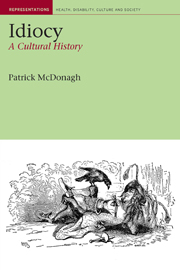Book contents
- Frontmatter
- Contents
- Preface and acknowledgements
- 1 Introduction: idiocy, culture and human relations
- 2 ‘Stripping our own hearts naked’: William Wordsworth and John Wilson read ‘The Idiot Boy’
- 3 A ‘pupil of innocent Nature!’ The wild boy of Aveyron goes to Paris
- 4 Diminished men: masculinity and idiocy
- 5 Essential women: femininity and idiocy
- 6 Holy fools, witty fools, depraved fools: folly, innocence and sin
- 7 History, society, economy: holy fools and idiots come home in nineteenth-century literature
- 8 Barnaby Rudge, idiocy and paternalism: assisting the ‘poor idiot’
- 9 Innocence, philanthropy and economics: the new ‘asylum’ idiot
- 10 Sensational idiocy
- 11 ‘The sins of the fathers’: idiocy, evolution and degeneration
- 12 Danger and degeneracy: the threat of the urban idiot
- 13 The problem of the feeble-minded: the Royal Commission, eugenics and eternal chaos
- Epilogue
- Bibliography
- Index
3 - A ‘pupil of innocent Nature!’ The wild boy of Aveyron goes to Paris
- Frontmatter
- Contents
- Preface and acknowledgements
- 1 Introduction: idiocy, culture and human relations
- 2 ‘Stripping our own hearts naked’: William Wordsworth and John Wilson read ‘The Idiot Boy’
- 3 A ‘pupil of innocent Nature!’ The wild boy of Aveyron goes to Paris
- 4 Diminished men: masculinity and idiocy
- 5 Essential women: femininity and idiocy
- 6 Holy fools, witty fools, depraved fools: folly, innocence and sin
- 7 History, society, economy: holy fools and idiots come home in nineteenth-century literature
- 8 Barnaby Rudge, idiocy and paternalism: assisting the ‘poor idiot’
- 9 Innocence, philanthropy and economics: the new ‘asylum’ idiot
- 10 Sensational idiocy
- 11 ‘The sins of the fathers’: idiocy, evolution and degeneration
- 12 Danger and degeneracy: the threat of the urban idiot
- 13 The problem of the feeble-minded: the Royal Commission, eugenics and eternal chaos
- Epilogue
- Bibliography
- Index
Summary
In March 1797, a boy, about twelve years old and apparently feral, was caught by woodsmen in the fields around the town of Lacaune, in the rolling hills of southern France. He escaped after being on show briefly, was apprehended again in summer 1798, and again fled to the woods after several days. He was caught yet again by three hunters in mid-July of 1799, and was left with a peasant, who fed him on potatoes and nuts, the only food he accepted; he escaped – yet again – after eight days. Finally, he reappeared for good on 8 January 1800, in the village of Saint-Sernin in the district of Aveyron, where, perhaps motivated by hunger and remembering the kindness of the peasant, he approached the workshop of a dyer named Vidal, who took him in and called the appropriate authorities.
The wild boy was a sensation. Crowds gathered to see him in Saint-Affrique, where he was first placed in an orphanage; in Rodez, where he was transferred for observation to the custody of Abbé Pierre- Joseph Bonnaterre, professor of natural history at the École Centrale de l'Aveyron; and then in Paris, when, six months after entering Vidal's atelier, he first arrived at the Institution Impériale des Sourds-Muets (the Imperial Institute for Deaf-Mutes), headed by Abbé Roche-Ambroise Sicard. ‘L'enfant sauvage de l'Aveyron’, as he quickly became known, was a nine-day wonder in French media and society.
- Type
- Chapter
- Information
- IdiocyA Cultural History, pp. 50 - 78Publisher: Liverpool University PressPrint publication year: 2008



